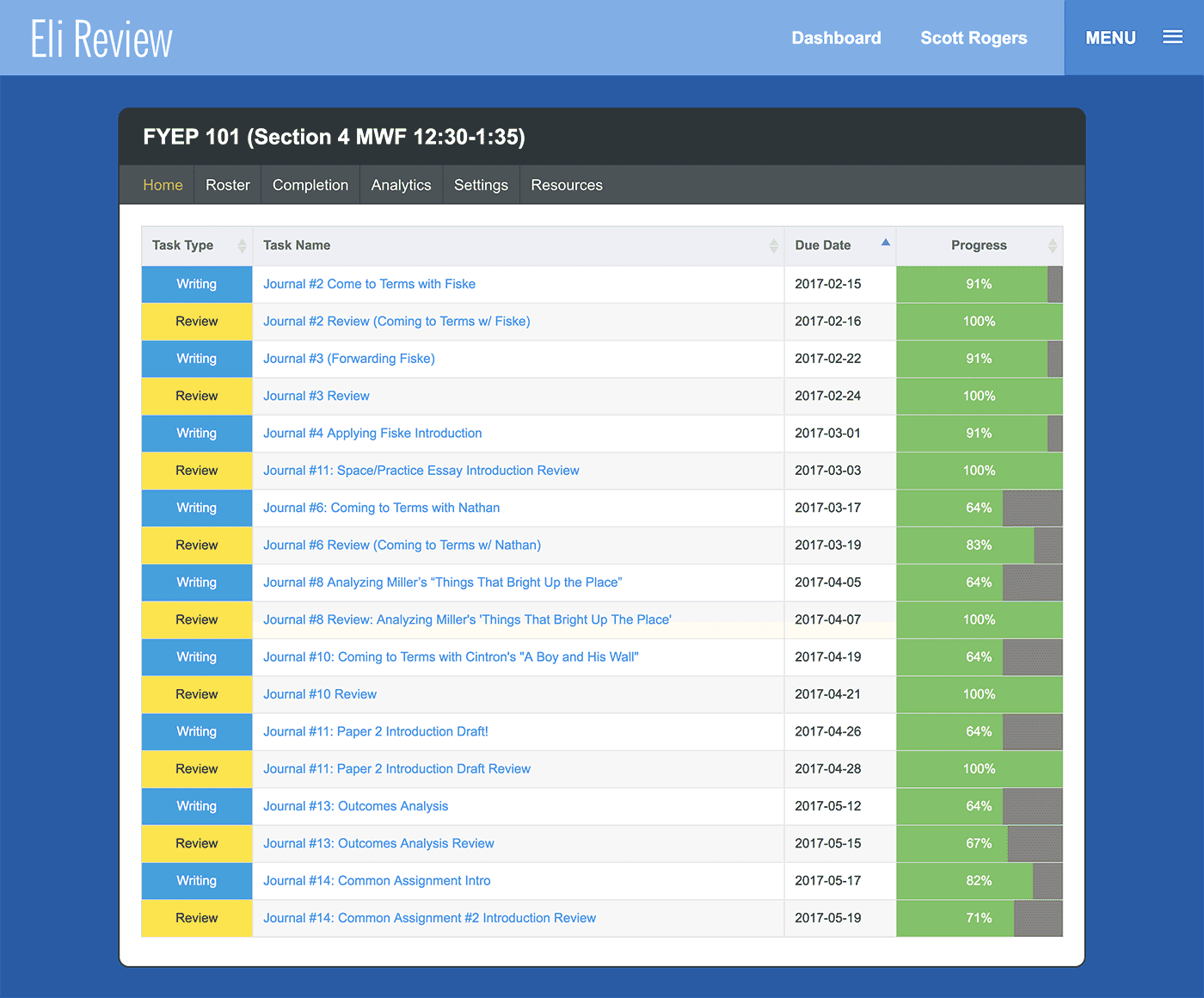
Scott Rogers (Twitter), Assistant Professor of English and Director of the Writing Center at Pacific Lutheran University in Tacoma, Washington, is a long-time Eli Review user who has figured out several contexts and purposes where the app works well. In this profile, Scott shares why he gave Eli Review a second try after a rocky first implementation.
What motivated you to try Eli Review?
In 2013, while I was at my previous institution, I gave the app a try on my own. I had seen something about Eli Review at a conference and looked it up once I got home. I started using Eli Review really just as a way to divert class time away from terrible feedback—like it was driving me nuts. Eli gave me an opportunity to guide what students noticed and talked about in their feedback; on that basic level, the app works so well. I didn’t stick with it at the time for many reasons, mostly to do with access to technology on that campus.
Then, a few years ago, I gave a talk at my current institution, Pacific Lutheran University, entitled “Do Less Stuff; Spend More Time on It.” That became my philosophy. I realized I was trying to do too much, trying to accomplish too much in every class I was teaching. I really wanted to simplify. What I was looking for, particularly in ENG 101, was a way to iterate—to have students write small drafts and make changes to those drafts to build toward new things.
I remembered Eli Review as something that could help me with that. It suits scaffolded learning really well: small assignments, lots of reflection, lots of communication, lots of peer review. That kind of hands-on, short bursts of energy, followed by lots of talk is what I was really trying for, and Eli is perfect for it.
How do you use Eli to scaffold writing projects?
I have a statement in my syllabus: “Writing is revising.” I try to make the entire course about revision. We do several small drafts, building little pieces of papers together, revising those things, growing the pieces like a science experiment into a much larger project.
In my class, students share parts of their writing journal in Eli Review. For each major assignment, we have a series of journal writing prompts, which are those small pieces that we’re building. I introduce Eli as kind of the intervention piece between each of those journals. We’ll drop the journal in Eli and use Eli to provide review and to flesh out our ideas; then we will revise. Later, we’ll take that piece and combine it with other pieces we’ve created in the journal to build a larger paper.
I build Eli Review into the logic of the assignment sequences so that giving feedback and using it to revise becomes second nature. They know we do peer review as part of the process of drafting a short piece and then it’s also part of that longer piece as well.
I also use Eli to scaffold the process so that each review is building on things they’ve done in the past. For example, there’s one core move for journal one. Journal two will have that same core move and then add a new one; then, journal three, the same. We’re using Eli to build skills because of the way you can draw questions around and can echo things you’ve done before. It’s all so neatly packaged there together: students can see what they’ve said before and what they’re saying now.

Why are you confident that the work you are doing in Eli Review is helping students get better at giving feedback?
There comes a point in every semester when the students start to sound like me in Eli Review. That’s the moment where I’m like, “Okay, this is finally working!” The first few times we use it, I get this smattering of voices, and I don’t really see any consistency in the kind of comments students are giving. Through discussions we have in class, through discussions we have using Eli Review when we look at it the responses on the projector, it starts to become clear that they’re now parroting or embodying the voice of the assignment. They are using the ideology of the prompts and what we’re trying to accomplish as a group. For me, that’s the moment where I’m thinking, “Okay, good. This is really working.” Then I can see it in their papers. I can see not only their feedback improving, but then their papers are improving as well.
What tips would you give an instructor using Eli for the first time?
First, read the documentation, because it’s excellent. The resources are so helpful for figuring out not only what Eli Review can do but also how Eli can reshape the way you think about writing process strategies for teaching writing.
Second, keep it short. This is a mistake I made early on. I had these long, sprawling assignments that were really difficult to review. They were even difficult to see online. After I started using shorter assignments, shorter bursts of energy, and with lots of reflection and conversation, the tool just kind of snapped into focus and started helping us quite a bit. Keep those assignments short by limiting page/word count. Keep the reviews relatively short. Don’t use every question type in a review. Short, focused activities help students learn.

